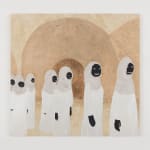Kelton Campos Fausto
aṣọ funfun, 2024
pigmentos naturais e acrílica sobre tela
[natural pigments and acrylic on canvas]
[natural pigments and acrylic on canvas]
140 x 147 x 3.5 cm
[55 1/8 x 57 7/8 x 1 3/8 in]
[55 1/8 x 57 7/8 x 1 3/8 in]
Copyright O Artista
Mais imagens
-
(View a larger image of thumbnail 1
)

-
(View a larger image of thumbnail 2
)

-
(View a larger image of thumbnail 3
)

-
(View a larger image of thumbnail 4
)

-
(View a larger image of thumbnail 5
)

-
(View a larger image of thumbnail 6
)

-
(View a larger image of thumbnail 7
)

-
(View a larger image of thumbnail 8
)

'aṣọ funfun' (roupas brancas) retrata os seguidores de Obatalá, que vestem branco em homenagem à divindade, guardião do conhecimento e da força vital na cosmologia Iorubá. Obatalá, o grande artista...
"aṣọ funfun" (roupas brancas) retrata os seguidores de Obatalá, que vestem branco em homenagem à divindade, guardião do conhecimento e da força vital na cosmologia Iorubá. Obatalá, o grande artista que moldou a humanidade na terra (àiyé), é celebrado enquanto essas figuras caminham pelo plano espiritual (ọ̀run). A obra reflete o trânsito entre os dois mundos, onde a alma reside no àiyé, mas o espírito visita o ọ̀run. Embora aceitemos o esquecimento ao chegar na terra, a pintura sugere que nossa conexão com o plano espiritual permanece viva, revelando um elo contínuo entre ambos os planos.
[“aṣọ funfun” (white clothes) depicts the followers of Obatalá, who wear white in homage to the deity, guardian of knowledge and the life force in Yoruba cosmology. Obatalá, the great artist who shaped humanity on earth (àiyé), is celebrated as these figures walk through the spiritual plane (ọ̀run). The work reflects the transit between the two worlds, where the soul resides in the àiyé, but the spirit visits the ọ̀run. Although we accept oblivion when we arrive on earth, the painting suggests that our connection with the spiritual plane remains alive, revealing a continuous link between both planes.]
[“aṣọ funfun” (white clothes) depicts the followers of Obatalá, who wear white in homage to the deity, guardian of knowledge and the life force in Yoruba cosmology. Obatalá, the great artist who shaped humanity on earth (àiyé), is celebrated as these figures walk through the spiritual plane (ọ̀run). The work reflects the transit between the two worlds, where the soul resides in the àiyé, but the spirit visits the ọ̀run. Although we accept oblivion when we arrive on earth, the painting suggests that our connection with the spiritual plane remains alive, revealing a continuous link between both planes.]
Na galeria
Ègbé ọ̀run Ẹgbẹ́ àiyé | A Gentil Carioca | Rio de Janeiro | Brasil [Brazil] | [23.11.2024 - 01.02.2025]15
de
15







